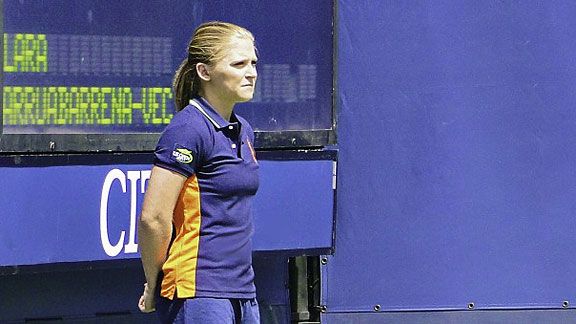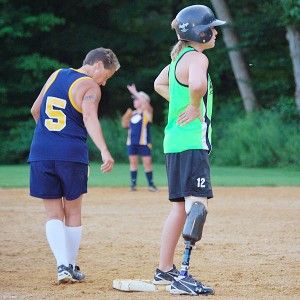Originally Published: On the Baseline Tennis News
Flushing Meadows, NY—A little extra rain in the morning hours couldn’t stop Super Semifinal Saturday at the U.S. Open. While the men played the afternoon session, the women kicked off the night session, with Sam Stosur taking on first-time opponent, Angelique Kerber under the lights of Grandstand Stadium. That match was followed by Caroline Wozniacki and Serena Williams on Arthur Ashe Stadium. Due to the rain delays earlier in the week, the U.S. Open was forced to find an alternate venue for one of the women’s semifinal matches. Armstrong was out of commission due to a water damaged court, so Grandstand it was. It didn’t have the grandeur of Arthur Ashe Stadium, but the intimacy of the court (with no reserved seating) made it a special treat for fans to get an up close view.
World No. 92 Angelique Kerber made her Grand Slam semifinal debut last night, upsetting both Aggie Radwanska and Flavia Pennetta en route to the semifinal. Prior to the U.S. Open, the 23-year-old leftie had lost in the first round of the last four Grand Slams, and had won only one match in her three previous US Open appearances. This time around, she won five matches in a row.
Sam Stosur was playing her third Grand Slam semifinal (first U.S. Open semifinal) and defeated Vera Zvonareva in the quarterfinals to get to this stage. She is the first Australian woman to reach U.S. Open semifinals since Wendy Turnbull in 1984, the same year that Stosur was born.
When the match began, Stosur took the first two games easily, and an early 3-0 lead, but Kerber held her serve, winning her first game against Stosur at 3-1. In the sixth game, Kerber held again, but Stosur maintained a comfortable lead in the first set at 4-2. Kerber began to show some signs of frustration, with more audible screeches after every racquet swing. It didn’t seem to help much. Stosur took the game, bringing the score to 5-2. Momentum began to shift in Kerber’s favor, when she scored her first ace of the match and won the game at 5-3, but Stosur prevailed, taking the first set 6-3.
As the more experienced player, Stosur seemed to be on her way to a straight set victory, but lost some concentration and momentum in the second set. Kerber, with a triple break point, took a 3-1 lead and was dictating points. Stosur held serve at 4-2, but with Stosur’s shaky forehand, Kerber went on to win the next two games, breaking Stosur (and the handle of her racquet) to take the second set 6-2.
Stosur switched gears in the third set, and consistently dominated at the net, winning 27 out of 29 net approaches. She quickly advanced to a 5-0 lead, but couldn’t close it out, giving Kerber the next two games. In what seemed to be the longest game of the match, Stosur fought back, to win the set 6-2, and the match.
After the match, Kerber admitted to having some nerves. “The first few games was too fast for me,” said Kerber. “I came out there and it was everything new for me, so many people and the lights.”
Sam Stosur is the fifth Australian woman in the Open Era to reach U.S. Open final after Margaret Court, Evonne Goolagong Cawley, Kerry Reid, and Wendy Turnbull.
“It’s great now that I’ve got a second chance to try and win one of these titles. I’ll definitely go out there and give it my best shot,” said Stosur.
Serena Williams and Caroline Wozniacki played the second semifinal match of the night on Arthur Ashe stadium. Both are very fit players, but there was no denying that Serena, with 13 Grand Slam titles and three U.S. Open titles was the favorite going into the match. She also had an 18-0 W/L record on hard courts this year, and had not dropped a set leading up to the semis.
No. 1 seed Caroline Wozniacki was bidding to reach her second U.S. Open final (runner up in ’09). She defeated Kuznetsova and Petkovic en route to the semifinals, and had only lost one set.
At the start of the first set, Serena took an early 2-1 lead. Wozniacki put some pressure on in the fourth game (which lasted over six minutes), but Serena prevailed, taking a 4-1 lead. During the changeover, Serena called for the trainer for pain in her right foot, followed by a medical time out to deal with toe pain. Serena quickly rebounded and took the first set 6-2. It was apparent that Wozniacki was playing to survive more than to win. She simply didn’t have enough power to battle back against Serena, earning zero winners in the first set, compared to Serena’s 15.
In the second set, Serena took a 3-1 lead, and in the blink of an eye, advanced to 5-3. She had been dominating at the net throughout the match, winning 17 out of 21 net approaches, compared to Wozniacki, who won just 1 out of 3. Serena was serving for the match at 5-3 when Wozniacki broke Serena, but it wasn’t enough. Serena won the match 6-2, 6-4.
“That serve was just a killer,” said Wozniacki, in her post-match press conference..
Having won the semifinal, Serena Williams is projected to rise to No.16. No. 12 if she wins the title.





